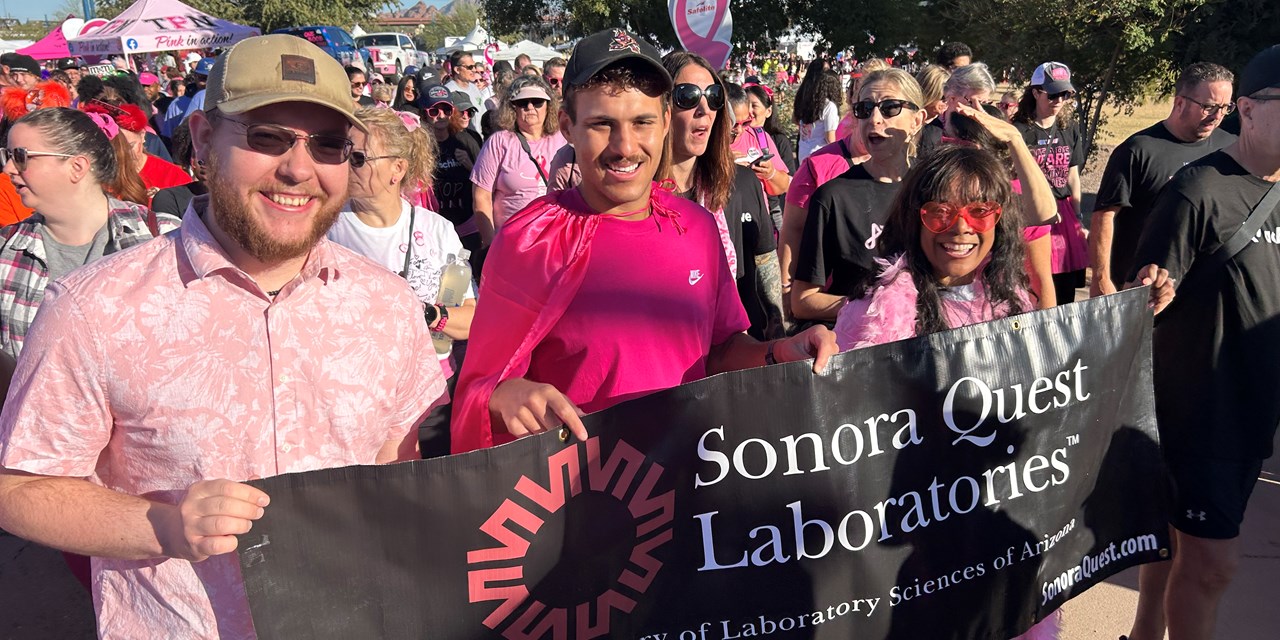COVID-19: See if You’re Eligible for $0 Out-Of-Pocket Testing
Newsroom

A Personal Battle With Cervical Cancer and My Mission to Improve Screenings
Tuesday, January 23, 2024 | Category: Media Coverage
By: Sonya Engle, COO of Sonora Quest Laboratories (Photo: Far Right)
I was 25 years old when I had my first cervical biopsy to check a few abnormal cells that showed up on a routine Pap smear. This was followed by a conization in which more of my cervix was removed. When the oncologist sat across from me a few weeks later to explain I had cervical cancer, I was stunned and confused. I began treatment shortly after, which included nearly nine months of chemotherapy.
I kept thinking back to all the Pap smears I had. At the time, I was already working in the laboratory industry and truly felt that my cervical cancer could have been caught earlier. I was going to the gynecologist regularly, and yet it was still missed. Why? Despite its importance and significance in the history of cervical cancer screening, the sensitivity of a Pap smear is low in detecting cervical cancer. Since precancerous cells can be missed and progress slowly to cancerous cells over the years, it is important to get regular screenings to prevent cancer. It wasn’t until the 1980s that a link between human papillomavirus (HPV) and cervical cancer was made.
While I was never diagnosed with HPV, one of the biggest causes of cervical cancer is HPV (~99%). Although this is a sensitive topic and there continue to be outdated stigmas surrounding HPV, conversations about screening for cervical cancer in the context of HPV infection must be had. We also must raise awareness and start to address this important reality.
Fortunately, my cancer has been in remission for two decades, but my experience made me want to get involved in education and advocacy, so no other women would have to go through what I did. It has also made me highly interested in cervical cancer, its risk factors, and how it is being diagnosed.
It is important to note that cervical cancer caused by HPV, on average, claims the lives of more than 4,000 women annually, with approximately 14,000 newly diagnosed cases, according to the American Cancer Society (ACS). However, the staggering reality is there are an estimated 24 million active cases of HPV and 5.5 million new cases in both men and women each year. Add to these stats the number of women overdue for cervical cancer screenings, which increased from 14% in 2005 to 23% in 2019, and the problem becomes more widespread.
When I was diagnosed in the 1990s, only a Pap test, or cervical cytology, was used to screen women. Now, more effective screenings are available to reduce the incidence of cervical cancer. That’s why, for me, the most exciting part about working at Sonora Quest is that I can tap into the expertise of our exceptionally knowledgeable medical laboratory scientists and clinicians. In addition, we are all focused on testing innovations to improve patient outcomes by offering all approved screening modalities including the new primary HPV test.
In a recent conversation with Dr. Stacy White, our Scientific Medical Director in the Molecular Division, she explained the advancements made in the diagnosis of cervical cancer due to the introduction of highly sensitive molecular tests for the detection of 14 high-risk HPV strains associated with cervical cancer. These tests detect the presence of high-risk HPV directly, allowing appropriate management of the patient before cancerous cells can develop and spread.
There is now enough data collected on the test's performance that the FDA has approved certain molecular tests, such as primary HPV, to be performed without the need for a Pap smear. This is supported by various organizations such as the US Preventive Services Task Force and American Congress of Obstetricians and Gynecologists. In addition, ACS states that primary HPV testing is the preferred screening method for cervical cancer.
As someone who has navigated cancer, I appreciate the quicker, more accurate, and more extensive testing available today. In addition to the advancement in testing, the primary HPV test turnaround time is 1 – 3 days (compared to 5 days with Pap) with most results coming back in just two days. This means the primary HPV test can help reduce the stress on patients by producing faster, more reliable results so they can start treatment sooner.
Today I am happy to be active and in good health. And I’m proud to be part of a laboratory team that is dedicated to improving testing that leads to early and accurate detection that ultimately helps save lives. If I can help just one woman have access to timelier, more comprehensive testing, I’ll consider that a win.